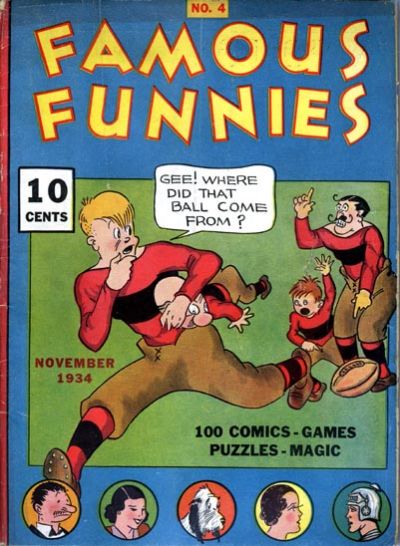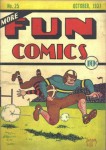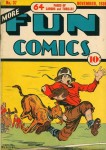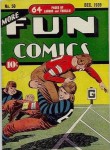It seems that the college bowl games of old are now named after their chief sponsors, so why not have the “Golden Age of Comic Books Bowl”! Well, I don’t have the budget of the Fortune 500 companies whose names grace the bowl games these days, so I’ll have to settle for showcasing some Golden Age comic book covers featuring the great game of football.
The titles that win the prize for the most Golden Age (and pre-Golden Age) football covers are Famous Funnies and More Fun Comics. The earliest football cover I could find was Famous Funnies #4 (November 1934).

Famous Funnies didn’t stop there, and had a great run of football themed covers that ran through 1941 (with the exception of 1938 and 1939) as follows:
More Fun Comics also had some early football covers starting with issue #15 (November 1936).
More Fun Comics had three more Golden Age football covers that ran consecutively from 1937 through 1939:
In addition to More Fun Comics and Famous Funnies, other Golden Age publishers recognized America’s Fall football passion, and tempted comic book readers with other football covers. For instance, Walt Disney Comics & Stories #26 (November 1942) features Donald Duck carrying the pigskin in the wake of terrified bugs!
Pep Comics, first known for it’s superhero, The Shield, and later devoted exclusively to Archie Andrews and his friends, featured two football covers. The first (issue #44, December 1943) features The Shield kicking a field goal with a pigskin caricature of Archie while Jughead serves as the holder. A bizarre sight, indeed!
A year later, in issue #51 (December 1944), the cover of Pep Comics features Archie showing off his football skills for Veronica. Unfortunately for poor Archie, his father is less than amused that the tires have been removed from his car to aid Archie in his quest to become a great football player!
The superheroes also got into football during the Golden Age of Comic Books. Batman uses a well kicked ball to subdue a crook on the cover of Detective Comics #82 (December 1943). Interestingly, this is the same month and year that The Shield was kicking Archie through the goal posts for 3 points.
Superboy played a little football on the cover of Adventure Comics#207 (December 1954) when he helps “Smallville’s Worst Athlete” score seven points.
I even found an obscure title, 4-Most Comics, that featured a football cover on its 20th issue (Fall 1946).
I would be remiss as a Golden Age of Comic Books historian if I didn’t mention what is likely the most famous football story from that era. While not a “football cover”, it is one of the most famous (and valuable) Golden Age comics. You probably already figured out that I am referring to Flash Comics#1 (January 1940) featuring the origin and first appearance of the Golden Age Flash (and the Golden Age Hawkman in a separate story). In the Flash story (written by the prolific Gardner Fox and drawn by Harry Lampert) we learn that Jay Garrick is shunned by his girlfriend (and later wife) Joan because he won’t put his mind to football. Jay tries, but earns the nickname “leadfoot” because he is so slow on the field. Of course, Jay is soon exposed to “hard water” in a laboratory accident and becomes the fastest man alive as a result. As soon as he recovers, Jay tries his new-found speed on the football field and is an instant star, being carried off the field by his teammates in triumph after winning the game 65-30 after being down 30-0 before the coach put Jay in the game.
As the bowl games begin, may the best team win, as long as it’s yours! Happy “bowl season” from the Golden Age of Comic Books!



















4 Responses to The “Golden Age of Comic Books Bowl”